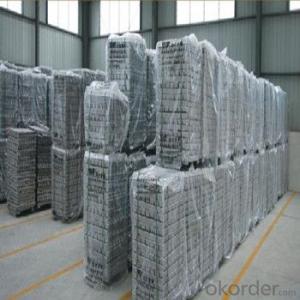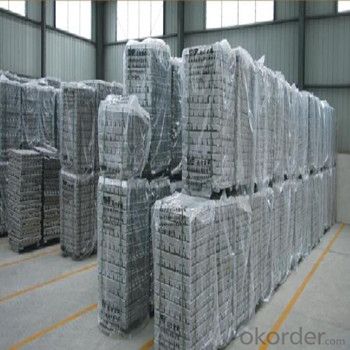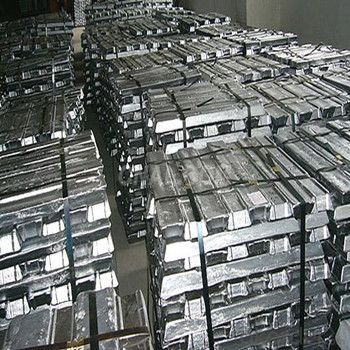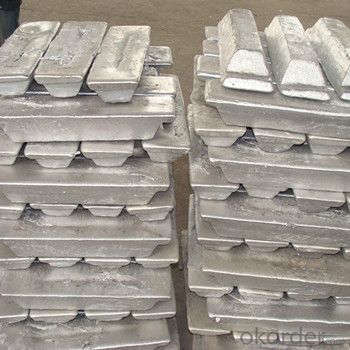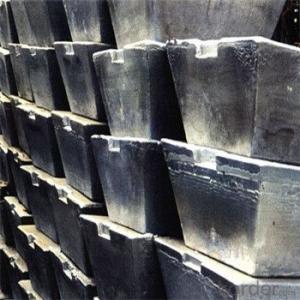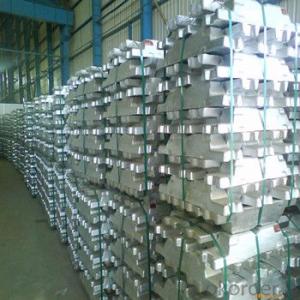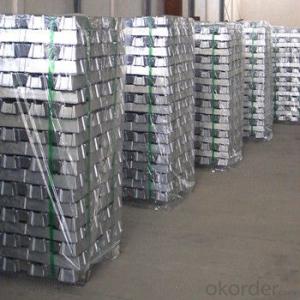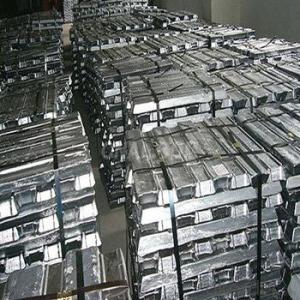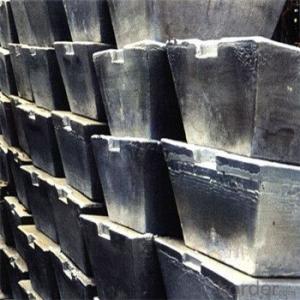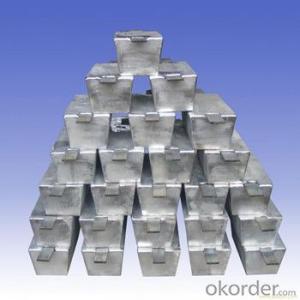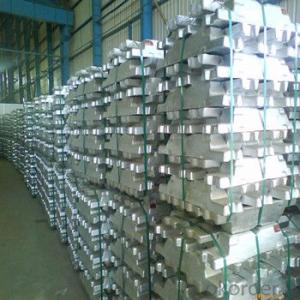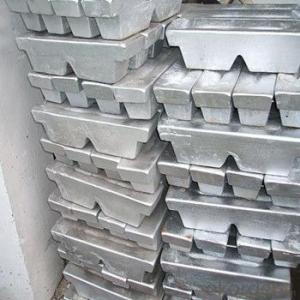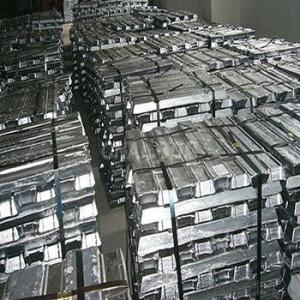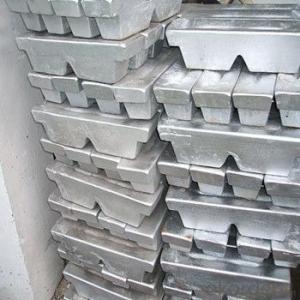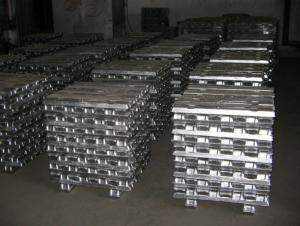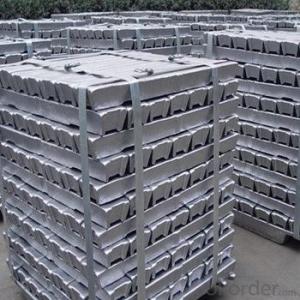Aluminium Ingot with Competitive Price and High Purity
- Loading Port:
- China main port
- Payment Terms:
- TT OR LC
- Min Order Qty:
- 1000 m.t.
- Supply Capability:
- 10000 m.t./month
OKorder Service Pledge
OKorder Financial Service
You Might Also Like
Pure Aluminum Ingot Used for Industry
1.Structure of Aluminum Ingot Description
Aluminum Ingot is with the AL as the main chemical composition. Aluminum Ingot is used for industry,such as automobile,pinning and weaving,electron broadly and so on. Aluminum Ingot has the following advantages: easy control and operation, fast melting.
2.Main Features of the Aluminum Ingot
•High Purity
•Easy control and operation
•High strength
•Fast melting
•Competitive price
•Best Service
3. Aluminum Ingot Images
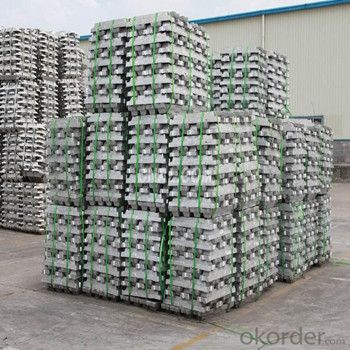
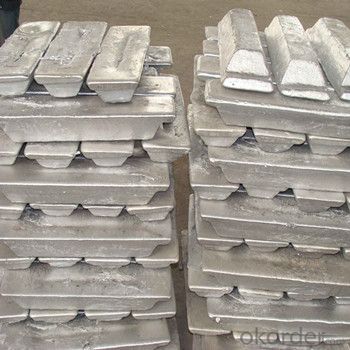
4. Aluminum Ingot Specification
Grade | Chemical Composition % | |||||||||
Al≥ | impurities ≤ | |||||||||
Si | Fe | Cu | Ga | Mg | Zn | Mn | others | Sum | ||
Al99.9 | 99.90 | 0.50 | 0.07 | 0.005 | 0.02 | 0.01 | 0.025 | - | 0.010 | 0.10 |
Al99.85 | 99.85 | 0.80 | 0.12 | 0.005 | 0.03 | 0.02 | 0.030 | - | 0.015 | 0.15 |
Al99.7 | 99.70 | 0.10 | 0.20 | 0.010 | 0.03 | 0.02 | 0.030 | - | 0.030 | 0.30 |
Al99.6 | 99.60 | 0.16 | 0.25 | 0.010 | 0.03 | 0.03 | 0.030 | - | 0.030 | 0.40 |
Al99.5 | 99.50 | 0.22 | 0.30 | 0.020 | 0.03 | 0.05 | 0.050 | - | 0.030 | 0.50 |
Al99.00 | 99.00 | 0.42 | 0.50 | 0.020 | 0.03 | 0.05 | 0.050 | - | 0.050 | 1.00 |
5.FAQ of Aluminum Ingot
We have organized several common questions for our clients,may help you sincerely:
①How about your company?
A world class manufacturer & supplier of castings forging in carbon steel and alloy steel,is one of the large-scale professional investment casting production bases in China,consisting of both casting foundry forging and machining factory. Annually more than 8000 tons Precision casting and forging parts are exported to markets in Europe,America and Japan. OEM casting and forging service available according to customer’s requirements.
②How to guarantee the quality of the products?
We have established the international advanced quality management system,every link from raw material to final product we have strict quality test;We resolutely put an end to unqualified products flowing into the market. At the same time, we will provide necessary follow-up service assurance.
③How long can we receive the product after purchase?
In the purchase of product within three working days, We will arrange the factory delivery as soon as possible. The pecific time of receiving is related to the state and position of customers.Commonly 7 to 10 working days can be served.
- Q: What are the different coating processes for aluminum ingots?
- Aluminum ingots can undergo various coating processes to improve their surface properties and protect against corrosion and environmental factors. Some commonly used coating processes for aluminum ingots include the following: 1. Anodizing: An electrochemical process is utilized to create an oxide layer on the ingot's surface. Anodizing not only provides excellent corrosion resistance but also allows for the application of dyes or paints to enhance the ingots' appearance. 2. Powder coating: Dry powder is applied to the ingot's surface and heated, resulting in the powder melting and forming a protective coating. This coating offers durability, aesthetic appeal, and resistance against corrosion, UV radiation, and chemicals. 3. Electrophoretic coating: Aluminum ingots are immersed in a paint solution that is electrically charged. The paint particles migrate to and deposit on the ingot's surface due to the electric field. Electrophoretic coatings provide excellent adhesion, corrosion resistance, and uniform coverage. 4. Chemical conversion coating: Aluminum ingots are treated with a chemical solution that reacts with the surface to create a protective coating. Common chemical conversion coatings include chromate, phosphate, and chromate-phosphate coatings. These coatings offer corrosion resistance and can serve as a base for paint or other decorative finishes. 5. Thermal spraying: A coating material, in the form of powders, wires, or rods, is heated and sprayed onto the ingot's surface. Thermal spraying results in a strong and durable coating that protects against wear, corrosion, and high temperatures. 6. Organic coatings: Liquid paints or lacquers are applied to the ingot's surface as organic coatings. These coatings provide a decorative finish and protect against corrosion and weathering. They are commonly used when aesthetics are a significant consideration. The choice of coating process depends on the specific requirements of the aluminum ingots and their intended application. Each process has its own advantages and disadvantages.
- Q: What are the dimensions of a typical aluminum ingot?
- The dimensions of a typical aluminum ingot vary, but they are commonly rectangular in shape and can measure approximately 20 inches long, 6 inches wide, and 3 inches thick. However, these dimensions can vary depending on the specific requirements and standards of the industry.
- Q: How are aluminum ingots used in the production of appliances?
- Aluminum ingots play a significant role in the production of appliances due to their inherent properties and characteristics. They are primarily used in the manufacturing process to create the outer casings, frames, and components of various appliances. One of the key reasons for using aluminum ingots is their lightweight nature. Aluminum is known to be a lightweight metal, making it an ideal choice for appliances where weight reduction is a crucial factor. This property allows manufacturers to design and produce appliances that are easier to handle, transport, and install. Additionally, aluminum ingots offer excellent corrosion resistance, which is essential for appliances that may come into contact with water or other corrosive substances. This property ensures that the appliances remain durable and long-lasting, maintaining their functionality and appearance over time. Another advantage of using aluminum ingots is their high thermal conductivity. This property enables appliances to distribute and dissipate heat efficiently, making them more energy-efficient and reducing the risk of overheating. This is particularly crucial for appliances such as refrigerators, air conditioners, and cooktops. Moreover, aluminum ingots are highly malleable and can be easily molded or formed into various shapes and sizes. This characteristic allows manufacturers to create intricate designs and customize the appearance of appliances according to consumer preferences. It also facilitates the integration of different components, such as handles, hinges, and buttons, into the appliance structure. Furthermore, aluminum ingots are recyclable, making them an environmentally friendly choice. The recycling process requires significantly less energy compared to the production of primary aluminum, reducing the carbon footprint associated with appliance manufacturing. In summary, aluminum ingots are extensively used in the production of appliances due to their lightweight nature, corrosion resistance, high thermal conductivity, malleability, and recyclability. These properties contribute to the production of appliances that are durable, energy-efficient, aesthetically pleasing, and environmentally friendly.
- Q: Can you melt the aluminium ingot?
- Cans are a mixture of several alloys, as well as aluminum surface treatment and printing impurities, etc., the production of aluminum alloy ingot sales is not a problem, mainly the price. In the domestic market Aluminum Alloy ingot is so large, that recycling aluminium ingot is simply not a thing.
- Q: Aluminum scrap and aluminum ingot in the intermediate frequency aluminum furnace, which is more energy saving?
- Tons of power consumption is basically the same!Theoretically, the aluminum ingot saves electricity.
- Q: How are aluminum ingots used in the production of doors and windows?
- Aluminum ingots are used in the production of doors and windows as they are melted down and shaped into extrusions, which are then used to create the frames and profiles of the doors and windows. These extrusions provide the structural strength, durability, and corrosion resistance necessary for high-quality door and window frames.
- Q: 15% of the iron in the ingot represents 1 tons of iron
- 150 kilograms, that is equivalent to 300 pounds.
- Q: How are aluminum ingots used in the production of electrical conductors?
- The production of electrical conductors heavily relies on aluminum ingots, which undergo a crucial transformation process. Initially, these ingots are melted and cast into different shapes, including wires, rods, or strips, depending on their intended use. The outstanding electrical conductivity of aluminum is one of the main factors contributing to its widespread use in electrical conductors. With approximately 61% of the electrical conductivity of copper, aluminum serves as a viable alternative in electrical applications. Moreover, its lightweight nature compared to copper offers advantages in terms of transportation and installation costs. To manufacture electrical conductors, the typical procedure involves various steps for processing aluminum ingots. Initially, the ingots are heated and extruded to form elongated aluminum rods or wires. These rods or wires are then drawn through a series of dies to decrease their diameter and increase their length. This wire drawing process refines the microstructure of aluminum, ultimately enhancing its electrical conductivity. Subsequently, the aluminum rods or wires undergo annealing to relieve any stress and enhance their mechanical properties. Following this, a thin layer of insulation, such as a polymer or enamel coating, may be applied to the aluminum conductors. This protective coating safeguards against electrical short circuits and corrosion. Once the aluminum conductors are prepared, they find application in a wide range of electrical uses. Commonly utilized in power transmission and distribution systems, aluminum conductors are frequently employed in overhead lines. Additionally, they are utilized in electrical cables, including building wiring and automotive wiring harnesses. To summarize, aluminum ingots are a vital component in the production of electrical conductors. Through processes like extrusion, wire drawing, and insulation application, aluminum ingots undergo a transformation into dependable and highly conductive components utilized in diverse electrical applications.
- Q: What is the difference between a aluminium ingot with and without a ticket?
- The general you do not vote, which they will put the invoice that give you the money saved, but why don't you take this ticket, if you can not keep the newspaper, after a document, you want to good, advise you best to say that, on the use of the receipt, not the authority
- Q: How are aluminum ingots used in the production of heat exchangers?
- Aluminum ingots are widely used in the production of heat exchangers due to their excellent thermal conductivity, lightweight properties, and corrosion resistance. Heat exchangers are devices that transfer heat between two or more fluids, and aluminum ingots play a crucial role in enhancing the efficiency and durability of these devices. To begin with, the thermal conductivity of aluminum is significantly higher than many other metals, making it an ideal material for heat exchangers. The high thermal conductivity allows for efficient heat transfer between the fluids, ensuring that the desired temperature exchange is achieved quickly and effectively. This property is especially beneficial in applications where heat transfer needs to be rapid, such as in automotive radiators or air conditioning systems. Moreover, aluminum ingots offer a lightweight alternative to other metals like copper or steel. This is particularly advantageous for applications where weight reduction is critical, such as in aircraft or automotive industries. The lightweight nature of aluminum ingots not only helps in reducing overall system weight but also provides ease in handling and installation of heat exchangers. Furthermore, aluminum ingots possess excellent corrosion resistance properties, especially when subjected to harsh environments or corrosive fluids. This corrosion resistance is due to the formation of a thin, protective oxide layer on the surface of the aluminum, which prevents further oxidation and degradation. Heat exchangers often come into contact with various fluids, some of which may be corrosive. By using aluminum ingots, the risk of corrosion-related failures is minimized, ensuring the longevity and reliability of the heat exchanger. In addition to these advantages, aluminum ingots are also versatile in terms of fabrication and customization. They can be easily cast, extruded, or formed into complex shapes, allowing for the production of heat exchangers with intricate designs and optimized performance. This flexibility in manufacturing processes enables the production of heat exchangers that are tailored to specific requirements, enhancing their overall efficiency and effectiveness. In summary, aluminum ingots are essential components in the production of heat exchangers due to their superior thermal conductivity, lightweight properties, corrosion resistance, and versatility in fabrication. Their utilization in heat exchangers significantly improves heat transfer efficiency, reduces weight, ensures durability, and allows for customization, making them a preferred choice in various industries.
Send your message to us
Aluminium Ingot with Competitive Price and High Purity
- Loading Port:
- China main port
- Payment Terms:
- TT OR LC
- Min Order Qty:
- 1000 m.t.
- Supply Capability:
- 10000 m.t./month
OKorder Service Pledge
OKorder Financial Service
Similar products
Hot products
Hot Searches
